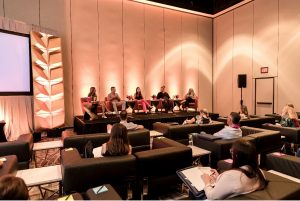CEMA SUMMIT In Review: The Art and Science of Transforming Events into Digital Experience
<< Back to Event Highlights | Posted on: October 22, 2021
Panelists: Matt Mongoven, SVP, Brand Experience, Freeman; Kristen Koenig Director, Digital Channel Sales & Partnerships, Freeman; Megan Morrison, Sr. Program Manager, Event Strategy, CDW; Angie Smith, Atlassian; Moderator: Lisa Van Rosendale. SVP, Brand Experiences, Freeman
At this Ignite Session, a panel of seasoned event marketers from both brand and provider communities shared their insights on the art of strategy, understanding human behavior both live and online to align with brand goals and optimizing the science of data analytics.

The discussion kicked off with a shared recognition that event executives – both on the brand and solutions provider sides – have been looking for “lifelines” and ways to plan, design and create with minimal visibility into what is around the corner. It has been a year of scenario planning for all of us.
All agreed that a good way to address uncertainty in direction is to lean into key learnings from the past year. For example, digital events in 2020 were often virtual versions of live events with typical 30-60 and 90-minute sessions. Attendee data across multiple verticals and varying audience segments indicate that a disciplined approach to content delivers the best results. It also indicates that online participants prefer bite-sized, consumable content. They also want to curate their own experiences, which makes it critical to understand a comprehensive attendee journey.
The panel also discussed the pros and cons of developing customized solutions vs. going with a SaaS solution. The consensus was that it’s not an either-or decision, similarly to what we encounter with LIVE events where we decide what properties go to a Tier 1 event versus what goes to a Tier 2 event. The key is employing the solutions that offers the best opportunity to innovate, differentiate and scale – up and down. It’s important to be intentional and create an authentic experience – no matter how you do it.
There were scores of other great insights shared. Here are a few of the most memorable ones:
- Event experiences must consider the entire eco system including but not limited to: customers, partner community and co-workers – and the event content strategy and platform technology must enable connections among the three.
- Event participants have become far more sophisticated about platforms and have higher expectations for user experience (UX) and user interfaces (UI). It’s our job to design an easy-to-navigate user experience, they don’t want to do the work for us.
- Digital content – their audiences are free to roam the world.
- To break through platform noise, develop a platform review and matching service that can match platforms to customer needs and culture and use analytics (AI and ML) to eliminate evaluation bias.
- Content must be deliberate, intentional, and authentic. Having an engaging, relevant, timely message is essential. Production can keep the story dynamic and interesting, and we should be open to using different content delivery mechanisms, including non-human presentations.
- Multi-channel which was embraced a few years ago is no longer acceptable and LIVE/HYBRID events are now part of the Omnichannel strategy.
- We need to change the conversation from Covid to crisis resilience. More disruption will happen, so EMs must develop a strategy for “force majeure” scenarios.
Session participants were invited to help crowd source solutions to real challenges the panelists were facing. For example, to motivate digital event audiences to return to the event experiences post event, hold impromptu live fireside chats (like Clubhouse), offer creative or unique information incentives (e. g. Easter eggs or sneak peeks), or have surprise, live expert drop-ins on your on-demand platform.
Of course, the parting wisdom was that since we’re all looking at the hazy crystal ball, we should turn to the amazing CEMA community for insight, expertise, and support.
